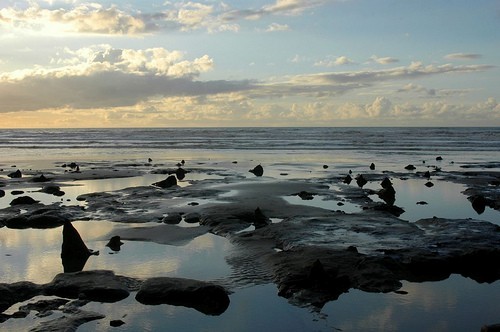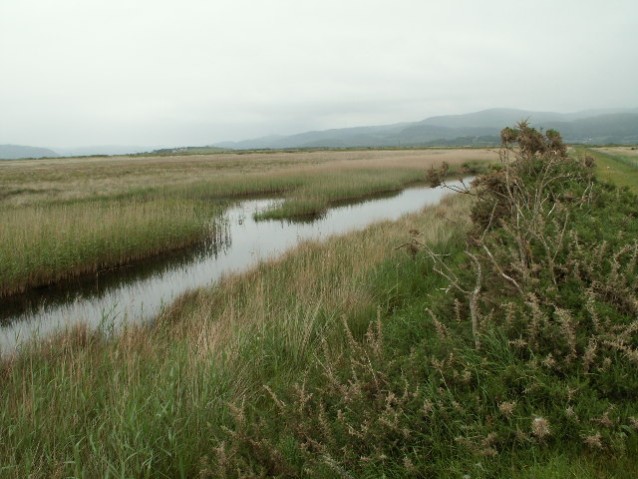Legends

Picture Courtesy of Kristi Herbert
SUBMERGED FOREST, BORTH BEACH
Borth is an old fishing village and is associated with many legends.
Borth beach has an ancient submerged forest, most of the time the forest is hidden by sand and the sea, but occasionally rough seas scour the sand away and then you see this at low tide along the beach, where stumps of oak, pine, birch, willow and hazel (preserved by the acid anaerobic conditions in the peat) can be seen. Radiocarbon dating suggests these trees died about 1500 BC.
This submerged forest is also associated with the legend of Cantre'r Gwaelod An old Welsh legend reveals a time before the area of Wales, a land called Cantre'r Gwaelod - which disappeared under the waters of Cardigan Bay.
Cantre'r Gwaelod (also known as Cantref Gwaelod or Cantref y Gwaelod; English: The Lowland Hundred) is the legendary ancient sunken kingdom said to have occupied a tract of fertile land lying between Ramsey Island and Bardsey Island in what is now Cardigan Bay to the west of Wales.
Cantre'r Gwaelod's capital was Caer Wyddno, seat of the ruler Gwyddno Garanhir. There are several versions of the myth. It is described as a walled country that was defended from the sea by a dyke called Sarn Badrig (Saint Patrick's causeway), over which two princes of the realm held charge.
One of these princes, called Seithenyn, is described in one version as a notorious drunkard and carouser, and it was through his negligence that the sea swept through the open floodgates, ruining the land.
The legend foretells of a land just like parts of Holland that was protected from being swamped by the sea via a series of dykes and dams. One night, a feast was being celebrated at Cantre'r Gwaelod.
Seithennyn, the man trusted with the post of staying clear-headed to man the watchtower that night and close the sea defence gates before high tide, let his fellow citizens down becoming inebriated, to the outcome that the sea pored through the defences, and the land of Cantre'r Gwaelod was completely submerged, the church bells of Cantre'r Gwaelod are said to ring out in times of danger.
The myth, like so many others, may be a folk memory of gradually rising sea levels at the end of the ice age; and its structure is comparable to the deluge myth found in nearly every ancient culture.
The physical remains of the preserved sunken forest at Borth, and of Sarn Badrig nearby, could have suggested that some great tragedy had overcome a community there long ago, and so the myth may have grown from that.
There is no reliable physical evidence of the substantial community that legend promises lies under the sea.
Reported sighting in 1770, Welsh antiquarian scholar William Owen Pughe reported seeing sunken human habitations about four miles off the Ceredigion coast, between the rivers Ystwyth and Teifi.
So this legend may have some truth to it, if only roots could talk, sea levels obviously had risen and whether the people of Cantre’r Gwaelod had taken steps to construct dams and dykes, or the land was flooded by a sudden catastrophic sea rise, will never be known unless the sea reveals its secrets one day.
CORS FOCHNO (BORTH BOG)

The edge of the Aberleri nature reserve on Cors Fochno (Borth Bog), looking north-west from near the railway.The slight mound in the near distance, just left of centre, is Ynys Mochno, one of islands in the former bog.
Cors Fochno is a raised peat mire located near to the village of Borth, in the county of Ceredigion, Wales. Lying on the south side of the Dyfi estuary, it forms a component part of the Dyfi National Nature Reserve. It is the only UNESCO (United Nations Educational, Scientific and Cultural Organization) biosphere reserve in Wales. A significant portion of the 652 acres (264 ha) former peatland complex was taken for agriculture; the surviving core area supports the largest expanse of primary near-natural raised bog in an estuarine context within the United Kingdom.
The Dyfi National Nature Reserve and visitors centre is located at Ynyslas, and the long distance footpath the Dyfi Valley Way passes through the Village.
Beside the local legends, there’s lots of things to see and do within the area, to the north and east of Borth is an area surrounded by protected sites; a massive peat bog - Cors Goch Fochno - and magnificent sand dunes of the Dyfi National Nature Reserve at Ynyslas.
Here you will find the seasonal Information Centre operated by the Countryside Council for Wales where the significance of the nature reserve is explained in easy to follow detail.
Borth, Ynyslas and Clarach are very popular destinations for touring caravan owners and campers, some of Wales' highest graded caravan and camping sites are found in the locality.
- Hits: 63750




